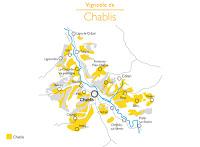 Many, many years ago, I remember relatives at family reunions quaffing wine from plastic cups. One source was a large bottle labeled Chablis, a generic American description for a light, perhaps off-dry white wine. In no way did it refer to the Burgundian wine region. And in no way did it resemble the mineral and acid driven Chardonnay the French Chablis region is known. Unfortunately it is still possible today to find mis-labelled American Chablis as the 2005 agreement with the EU, that was intended to end this practice, included a grandfather clause for producers who had been using the name. Why???
Many, many years ago, I remember relatives at family reunions quaffing wine from plastic cups. One source was a large bottle labeled Chablis, a generic American description for a light, perhaps off-dry white wine. In no way did it refer to the Burgundian wine region. And in no way did it resemble the mineral and acid driven Chardonnay the French Chablis region is known. Unfortunately it is still possible today to find mis-labelled American Chablis as the 2005 agreement with the EU, that was intended to end this practice, included a grandfather clause for producers who had been using the name. Why???
The Chablis to enjoy is in reality 100% Chardonnay from cold-climate northern Burgundy. The coldness traps acidity whereas the 150 million year old soil of Kimmeridgian Limestone - loaded with fossilized oyster shells - imparts noticeable amounts of minerals. Obviously this isn't your new world chardonnay. The Chablis region also maintains a Appellation D'Origine Controllee system with four classifications: Petit Chablis, Chablis, Chablis Premier Cru, and Chablis Grand Cru. The first two are broader in nature; while the second two consist of specific climats - or micro-terroirs.
During a #PureChablis tasting last week, Chef Ryan Hardy and Wine Director Arvid Rosengren of NYC's Carlie Bird restaurant lead a discuss of five Chablis wine and the appropriate food pairing for each. I will update this post with links to these pairings when they become available. In the meantime, here are the wines we tasted:
 Petit Chablis, La Chablisienne, 2015 ($15) The Petit Chablis "village" appellation can be produced across all the communes in the Chablis region. Petit wines usually come from a slightly different type of soils, called Portlandian limestone.This wine starts with light apples and limes, then saline, and refreshing acids - a great value.
Petit Chablis, La Chablisienne, 2015 ($15) The Petit Chablis "village" appellation can be produced across all the communes in the Chablis region. Petit wines usually come from a slightly different type of soils, called Portlandian limestone.This wine starts with light apples and limes, then saline, and refreshing acids - a great value. Chablis “Vauprin”, Roland Laventureux, 2014 ($26) - The appellation village of Chablis is produced in a specific list of communes. This "village" level wine is from a single vineyard and possesses tropical fruit and citrus, mint, chalky minerals, and fresh acids. Very delicisous.
 Chablis Premier Cru, Vaillons, Domaine Daniel Dampt, 2015 ($32) This wine is from the left bank of Chablis and in general, the Premier Crus add a layer of complexity and intensity. This wine has both plus stone fruit and melons, saline, and noticeable acids.
Chablis Premier Cru, Vaillons, Domaine Daniel Dampt, 2015 ($32) This wine is from the left bank of Chablis and in general, the Premier Crus add a layer of complexity and intensity. This wine has both plus stone fruit and melons, saline, and noticeable acids.Chablis Premier Cru, Fourchaume, William Fèvre, 2014 ($45) This wine is from the right bank, right next to Grand Cru plots. Fourchaume is well known among Chablis lovers and for good reason. The wine is excellent: green apples and lemons, hefty dose of minerals, bombastic acids.
Chablis Grand Cru, Valmur, Jean-Claude Bessin, 2014 ($54) Chablis Grand Cru accounts for only 2% of Chablis production. As Rosengren noted, this wine is "both rounder and more muscular at the same time". It is fantastic: pineapple aroma, saline and minerals, rounder, chalky, and strong acids.
